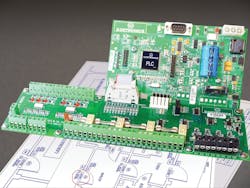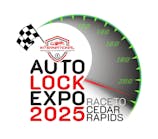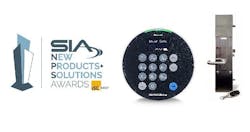Cleanrooms require stringent environmental controls and very low levels of particulates in the air to avoid contamination of intricate high-tech processes used in industries such as pharmaceuticals, medical engineering, electronics, optics and the food industry. Controlling access to these specialized environments is essential to the high-technology work that takes place in cleanrooms.
Cleanrooms also represent particularly complex environments for access control, usually involving multiple doors and mantraps, as well as a complex array of door locks, automatic door openers, indicator lights, and air dampers. Access to cleanrooms is also restricted to authorized personnel and may require special timing functions and/or special logic sequences to maintain the correct pressure level for a certain operation. In addition, some systems require personnel to adhere to a specific traffic pattern to ensure cleanliness or safety.
The use of programmable logic controllers (PLCs) provides greater flexibility to customize operation of complex access control systems to serve the needs of the cleanroom environment. Factory-programmed and tested PLC-based interlock controllers simplify design of access control systems for cleanrooms in applications that involve from two to more than 100 doors. Multiple interlocks can be operated from a single controller to sequence locks, traffic lights, exhaust fans and airtight seals. Interlock controllers can interface with electronic maglocks and strikes, automatic door openers, card access systems, biometric readers, traffic lights and alarm sounders. To ensure safety, interlock controllers also interface with operator safety mechanisms, building fire alarm systems and emergency shutdown systems.
While most systems use electric locks and/or automatic door operators, some cleanroom locations forbid or seriously limit the use of electric locks on pedestrian doors. Some cleanroom projects use no locking hardware, only traffic lights to indicate when doors should be accessed, but with an alarm sounder to indicate if the door is opened in violation. Delayed egress controls can be incorporated into interlocks to satisfy local building codes while ensuring the appropriate operation of the cleanroom doors.
Pressurized cleanrooms require air-tight seals on doors and frames plus special HVAC timing to maintain sterile conditions. The door seals must be maintained for proper operation. Automatic door operators or manual door closers must be specified and adjusted for the correct spring tension to ensure proper closing and re-sealing of the door after access. While door logic will inhibit another door from being opened until the accessed door is re-secured, a timing delay may be required to allow for a re-pressurization of the cleanroom. This time delay period should be coordinated with the HVAC contractor and the requirement specified as a feature of the interlock controller.
Airlocks, incorporating automatic doors, are used when materials and equipment must be moved between cleanroom areas. Automatic doors can also be used in sterile areas with “touchless” sensors to operate the doors without touching any surfaces. The automatic door operator can also control traffic flow direction by using request-for-access devices on one side only. Typically, the interlock controller would signal the operator when the door may be opened, but sometimes built-in time delays are needed to allow the door to unlock before the automatic operator attempts to open the cleanroom door. The door open timer can be adjusted, independent of the interlock control, to close after a preset time.
An industrial overhead door operator may be used with the door interlock controller by inhibiting the “open” button control when the door should not be accessed. Usually, the “close” and “stop” button controls are not inhibited by the interlock controller. For safety reasons, infra-red and safety edge devices should always remain fully functional. These will automatically reverse the door travel back to the open position.
Interlocked doors in mantrap areas can be equipped with LED traffic lights for user feedback. Indicators for normally unlocked doors will always follow the door lock status (green when unlocked and red when door is locked to prevent access.) “Go / No Go” lights indicate when normally locked doors are inhibited or are available for access.
Access control is a complex requirement of the cleanroom environment in order to ensure the integrity of processes that take place there. PLC-based interlock controllers simplify the critical task of providing access control in these specialized environments.
Bryan Sanderford is national sales manager, Dortronics Systems, Inc. For more information, visit www.dortronics.com.






